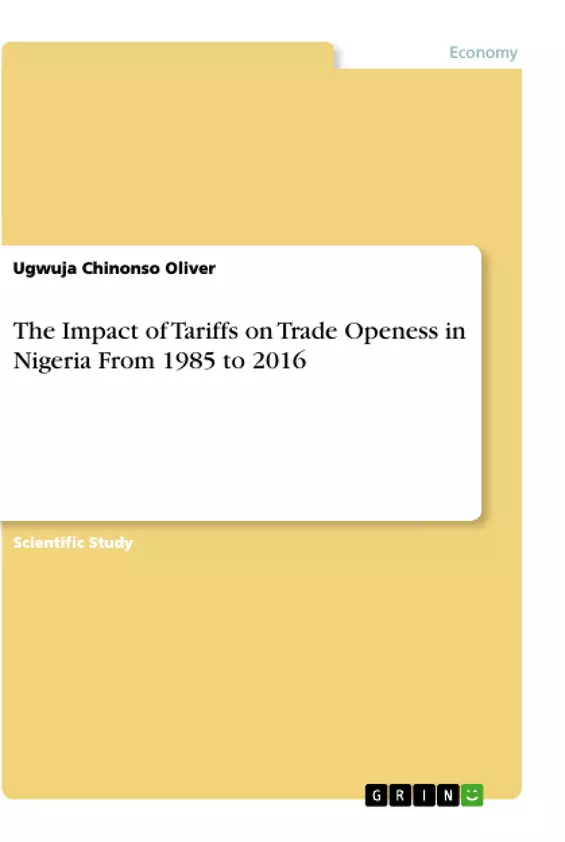This study however, empirically examined the impact of tariff rate on trade openness in Nigeria, relying on annual time series data spanning the period 1985-2016 and using the Engel-Granger two step co-integration test to establish the existence of a stable long run equilibrium relationship among the variables at a 5% level of significance
The debate over the effect of tariffs on trade openness is relatively virgin in international trade literature The study employed the Ordinary Least Square (OLS) regression technique and the pairwise granger causality test to validate the nature of the relationship existing between trade openness and tariff rate in Nigeria. Sequel to the regression result, it is found that although tariff variable is statistically insignificant, it has a negative effect on the degree of openness. Similarly, the granger causality reveals a uni-directional causality existing between TOPEN and TARF running only from trade openness to the rate of tariff.
The study therefore recommends that since TARF has proven to be an insignificant determinant of trade openness and is thus granger caused by the degree of openness, the government should leave tariff rate to be determined by the invisible hand of the free market-economy and not bother in fixing the tariff rate for the purpose of restricting the free flow of international trade.
Inhaltsverzeichnis (Table of Contents)
- Introduction
- Background of the Study
- Statement of the Problem
- Objectives of the Study
- Research Questions
- Scope and Limitation of the Study
- Significance of the Study
- Literature Review
- Theoretical Framework
- Empirical Review
- Methodology
- Data Sources
- Model Specification
- Estimation Technique
- Unit Root Test
- Cointegration Test
- Causality Test
- Results and Discussion
- Conclusion and Recommendations
- References
Zielsetzung und Themenschwerpunkte (Objectives and Key Themes)
This study aims to investigate the impact of tariff rates on trade openness in Nigeria using time series data from 1985 to 2016. The objective is to determine the nature of the relationship between tariff rates and trade openness, whether a long-run equilibrium exists, and whether there is a causal relationship between them. The study employs econometric techniques such as cointegration and Granger causality tests to establish these relationships.
- Impact of tariffs on trade openness
- Long-run equilibrium relationship between tariff rates and trade openness
- Causality relationship between tariffs and trade openness
- Economic policy implications of the findings
- Relevance of free market principles in trade policy
Zusammenfassung der Kapitel (Chapter Summaries)
- Introduction: This chapter introduces the study, providing a background on the relationship between tariffs and trade openness. It outlines the problem, research objectives, and significance of the study. It also discusses the scope and limitations.
- Literature Review: This chapter examines existing theoretical and empirical literature on the impact of tariffs on trade openness. It presents relevant theoretical frameworks and reviews previous studies conducted in this area.
- Methodology: This chapter details the research methodology employed in the study. It describes data sources, model specification, estimation techniques, unit root tests, cointegration tests, and causality tests used in the analysis.
- Results and Discussion: This chapter presents the results of the econometric analysis, including the findings from the unit root, cointegration, and Granger causality tests. The results are discussed in relation to the research questions and hypotheses.
Schlüsselwörter (Keywords)
Key terms and concepts associated with this study include tariffs, trade openness, cointegration, Granger causality, Nigeria, economic policy, free market, and international trade.
- Quote paper
- Ugwuja Chinonso Oliver (Author), 2018, The Impact of Tariffs on Trade Openess in Nigeria From 1985 to 2016, Munich, GRIN Verlag, https://www.grin.com/document/503047



